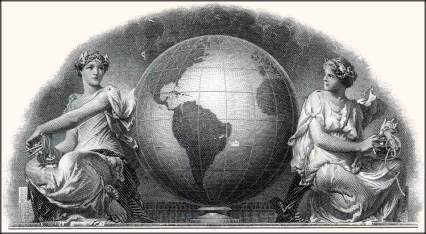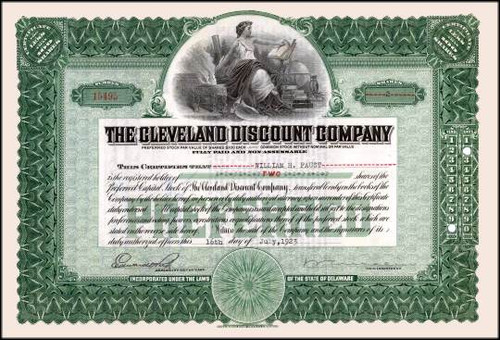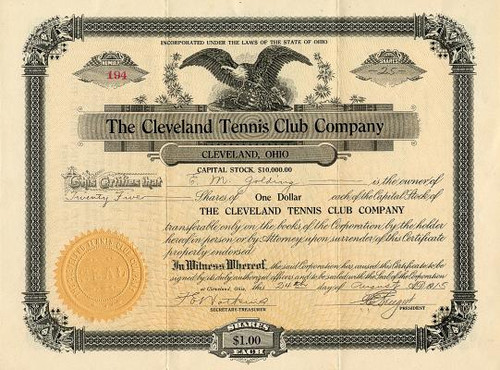Beautifully engraved certificate from the Cleveland Graphite Bronze Company issued in 1937-1950. This historic document was printed by the American Banknote Company and has an ornate border around it with a vignette of two allegorical women by a globe. This item has the printed signatures of the Company's President and Secretary and is over 52 years old. 
Certificate Vignette In the first third of the 20th century, the businesses under the Gould and Chase-Shawmut banners grew steadily, while the company that was to launch the Foil Division was formed. 1910--Gould's Foil Division has its origin in a company that began business as the Dann Spring Insert Company. It offered a patented tubular steel insert for automotive bearings. The company that would become the nation's leading maker of bearings and bushings changed its name in 1919 to the Cleveland Graphite Bronze Company. 1919--In Cleveland, Ohio, Charles Brush, Jr., formed a small research company with the objective of improving phonographic record sound through piezolelectric crystals. His death in 1927 prevented him from witnessing laboratory production of clear crystals and their perfection in products such as phonograph pick-ups, microphones and headphones. 1920--Chase-Shawmut became a stand alone entity as a result of a government anti-trust action against Stone & Webster. A period of vigorous growth followed, fueled by new products such as plug fuses, one-time fuses, time delay fuses, renewable fuses and floodlights. I-T-E, meanwhile, was expanding its product line to include switches, porcelain insulators and fuses to its product line, in addition to its mainstay circuit breaker product. 1930--National Battery Company, an outgrowth of Electrical Manufacturing Company, acquired the Gould business. At that time, National Battery was providing batteries for a number of leading national retailers, including Montgomery Ward, Western Auto, Goodrich and Goodyear. 1930--Partners in Brush Labs formed the Brush Development Company to bring to commercial fruition the laboratory's successes. The Great Depression, World War II, and the post-war boom saw an acceleration of progress among the businesses that were eventually unified as the Gould of today. 1936--Brush developed a high frequency, direct writing pen recorder system, which marked the beginning of the company's dominance in the physical test and measurement market. The discovery led to development of the surface analyzer and, in the 1940s, the oscillograph. 1942--Brush's technological leadership extended to military applications with the development of the MK-30 torpedo. The MK series became the U.S. Navy's primary underwater defense system for the next several decades. 1950--National Battery Company was renamed Gould-National Batteries, Inc., a name change that grew out of the desire of Albert H. Dagget, Shields' successor, to build the company's industrial battery business based on the Gould name and experience. Gould-National Batteries pioneered work in sealed-cell nickel cadmium batteries, helping to create a market for rechargeable appliances. 1950--The 101 Amp-trap fuse was introduced to protect another emerging technology, solid state semiconductor devices. 1952--Brush Development Company and Brush Labs merged, and later that year, the new entity merged with Cleveland Graphite Bronze Company, the world's largest manufacturer of sleeve bearings and bushings. Shortly after the merger, the company which united expertise in both metallurgy and electronics was renamed Clevite. 1953--The Chase-Shawmut and I-T-E paths converged when I-T-E Circuit Breaker Company acquired Chase-Shawmut. 1957--Cleveite launched a business that was to evolve into today's Foil Division. Clevite perfected a means of making foil without lead, and quickly emerged as the leading foil supplier to the fledgling printed circuit board industry. This period saw the convergence of Gould, I-T-E and Clevite, the forerunners of today's fiber optics, circuit protection and foil businesses, respectively. 1969--Gould National Battery acquired Clevite and the resulting combination was renamed Gould Inc. The company had sales of some $342 million. 1976--Gould acquired I-T-E, with $500 million in sales, which propelled Gould to $1.2 billion in revenues. In the years just prior to the merger, I-T-E had developed a host of new products including specialized fuses for the new breed of rapid transit trains and an impregnated fiberglass fuse body material called Supr-Tube. Late 1970s and early 1980s--Gould accelerated its efforts to become totally focused on electrical and electronics products. While many of these efforts involved acquisitions and divestitures, the company also attempted to develop new businesses through R&D. 1978--A group was formed which manufactured towed array sonar systems for the U.S. Navy. Early successes included development of a practical fused biconical taper (FBT). Shortly thereafter, Gould invented the fiber optic wavelength division multiplexer (WDM). 1983--Single mode fiber was being utilized in telecommunications and Gould began manufacturing components in the laboratory to address those needs. A year later (1984), the company decided to begin commercial manufacturing, and by 1985, the operation was housed within The Ocean Systems Division in Glen Burnie, Maryland. 1984--In its effort to achieve more of a high-tech focus, Gould divested the remnants of the original Gould National Batteries, then known as GNB Batteries. Shortly thereafter, however, the genesis of a more modern battery business occurred. Within the Gould Technology Group, research began on primary lithium batteries, and commercial production of "A" lithium batteries began. 1985--Gould's Fiber Optics business became a stand-alone division. 1986--The Fiber Optics Division was awarded a patent for its 2 x 2 coupler and began export to Japan, followed by export to Europe the next year. Mid-1980s--The overhaul and restructuring of Gould had proven to be financially disappointing. Many of the newer businesses the company acquired had failed to generate the earnings levels of some of Gould's more steady industrial businesses, which had been divested. As the financial condition of the company deteriorated, various business units were sold to generate cash. 1988--All of Gould's non-defense related businesses were acquired by Nippon Mining Company (now Japan Energy Corporation), which had been a joint venture partner with the Foil Division since 1981. With strong financial support from Japan Energy, the businesses that make up the Gould of today began rebuilding in the early 1990s. The foil, fuse and fiber optics businesses had always had strong operating profits, which were masked by costs of discontinued businesses. 1990s--Gould began a rebuilding process based on its core technological strengths in electrochemistry. The lithium battery business, Powerdex, added several sizes of primary batteries to its product mix and began working with major telecommunications and computer companies to supply them with thin rectangular rechargeable lithium ion polymer batteries. 1993--Gould launched the Copper Aluminum Copper Division, based on a licensed, patented technology involving one or two layers of copper foil sealed in a clean room environment around an aluminum separator sheet. This division enjoyed strong initial success and emerged quickly as a significant business for Gould. 1995--Gould's Electronic Materials business, also rooted in electrochemistry, became a stand-alone division. This division concentrates on flexible printed circuit materials and other specialty metal foils. 1996--ElectroCopper Products Limited was formed. This division unites solvent extraction of leached copper ores with direct electrodeposition of copper powders. Gould continues to meet customer needs through technological leadership and innovation, continuing a tradition established by its predecessors more than 100 years ago The company history was obtained from Gould Electronics.

Certificate Vignette














